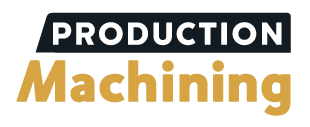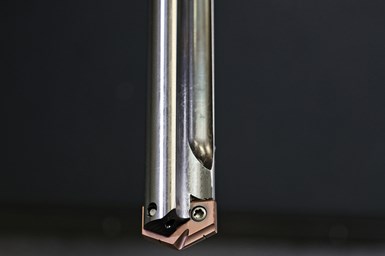Allied Insert for Cutting Stainless Steel, HRSA Materials
Appears in Print as: 'Insert for Cutting Stainless Steel, HRSA Materials'
Allied Machine and Engineering’s M geometry T-A Pro insert has been engineered to provide a combination of longer tool life, good penetration rates and process reliability for cutting stainless and heat-resistant super alloy materials.
Edited by Angela Osborne
Allied Machine and Engineering’s T-A Pro M geometry insert. Photo Credit: Allied Machine and Engineering
Allied Machine and Engineering’s T-A Pro M geometry insert targets stainless steel and heat-resistant super alloy (HRSA) materials. The company says the combination of the ISO-material class M geometry and margin design paired with the development of the AM460 coating provides a tool that offers low cutting forces, excellent penetration rates and long tool life in challenging stainless steel and heat-resistant super alloys.
The insert geometry is said to produce the best results with the newly designed T-A Pro holders, but is also compatible with T-A holders and is offered in the Z-3 series with diameters ranging from 0.437″ to 1.882″ (11.10 mm to 47.80 mm).
In industries such as aerospace, automotive, energy and food service that often machine stainless steel and HRSA materials, the cost-effectiveness and reliable performance of the M geometry insert are a necessity due to the high costs of these raw materials, which are among the highest in manufacturing, the company says. Because the use of these materials continues to grow in many industries, it is said improved drilling solutions such as the M geometry target difficult-to-machine materials — which is a key factor for remaining competitive in any market.
The design elements of the T-A Pro M geometry enable larger diameters, such as 1″ and larger, to be used on smaller or underpowered machines where additional setups on other machine tools would be needed or where parts would need to be contracted out. Machining components cost-effectively in-house, while meeting specifications every time, is said to ultimately increase throughput and profitability.
The M geometry T-A Pro insert has been engineered to provide a combination of tool life, penetration rate and process reliability so users can feel confident when applying the tool to their specific needs.
RELATED CONTENT
-
Advantages of Cellular Manufacturing
Manufacturing cells are used to minimize product movement as well as materials, equipment and labor during the manufacturing process. By reducing cycle times and material handling, these cells help shops more easily meet customer demands regarding cost, quality and leadtimes.
-
Collets Vs. Chucks
Find the definition, types and advantages of both CNC collets and chucks for workholding as well as the best applications for each, in this article.
-
5 Process Security Tips for Parting Off
Here are five rules of thumb from Scott Lewis, a product and application specialist at Sandvik Coromant, to optimize the parting off process, and as a result, maximize tool and insert life.




